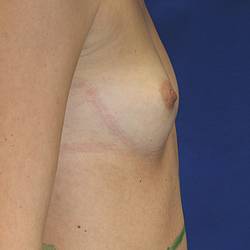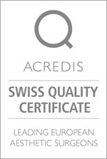Operation
How does the operation proceed?
First I explain the exact course of the operation again and answer any outstanding questions. After monitoring the important blood values, the areas for the liposuction and the fat enhancement are marked. After that, photos are taken and then once you are lying down, the skin is disinfected and you are covered with sterile towels. The procedure takes place using tranquilizing drugs (Dormicum tablets or venal injection).
The anesthetic fluid is injected into the areas for liposuction using an infiltration cannula. Then, the simultaneous flushing and suctioning of the fat cells take place. Because of the weak suction and the thin cannula this stage takes longer than with normal liposuction. As soon as there is enough fat in the collection vessel, as a next step the breast area is de-sensitized. The fat is now carefully filled into a 10ml syringe and is distributed evenly and carefully in thin layers into the breast, using a fine, blunt cannula with several lateral holes. Approximately 2/3 is injected into the subcutaneous fat layer and 1/3 is injected into the muscle. No fat is transferred into the glands themselves, as this is virtually impossible because of the tough tissue in this area. This also ensures that subsequent breast examinations can take place without restriction.
After the operation

You should take it easy for a few days at home, and after 2-3 days you can replace the cotton wrapping with a fitting nursing bra or go without a bra completely. Be careful not to apply any great pressure to the breasts and that you dress the upper body warmly. These measures help to support the growth of the fat cells. The breasts will be swollen and blue in some places for the first few days, but there should not be great pain. The suctioned areas may be rather sensitive, and the pain is described as “muscle ache”. After about a week, the swelling has reached its peak, and then the breast volume continues to decrease. At the end of the fourth week, the approximate final volume is attained, and there is still a tissue loss of about 10% for up to 3 months. After 3 months the result will permanently stabilize.
The bruising disappears within the next 2 weeks, but you should continue to wear the compression garments on the liposuctioned areas for about 4 weeks.
Risks and complications

A small proportion of the fat cells does not survive the transplant and are re-absorbed by the body. Over 80% of the fat transplanted with this method heals. The primary risk with an autogenous breast enlargement is the resorption of the unhealed fat cells. If many fat cells clump together and the body cannot break them down, then oily nodes can form. The Beauli-Technik™ that we use employs a fine, even distribution into the tissue, so that this problem can largely be avoided. In very rare cases, an infection can occur, but these are generally treatable with antibiotics.
The right mode is critical

Fat injections were and are still today being done today without real attention to the correct handling of the fat cells. Sometimes the fat recovered from an ordinary liposuction is sprayed directly into the breast using large cannulae. Then a large proportion of the cells dies, and loses their content - oil. With large fat clusters, the accumulated oil is no longer decomposed by the body, but is sequestered with a tissue covering. This covering can later calcify and lead to a hardening in the breast.
A higher breast cancer risk is unlikely and has not been documented as yet. Because no fat cells are transferred into glands themselves, any subsequent breast examinations (e.g. a mammogram) can be executed without reservation. This is in contrast to the method using silicone implants: in that case, the evaluation of the mammogram is complicated or no longer possible.





